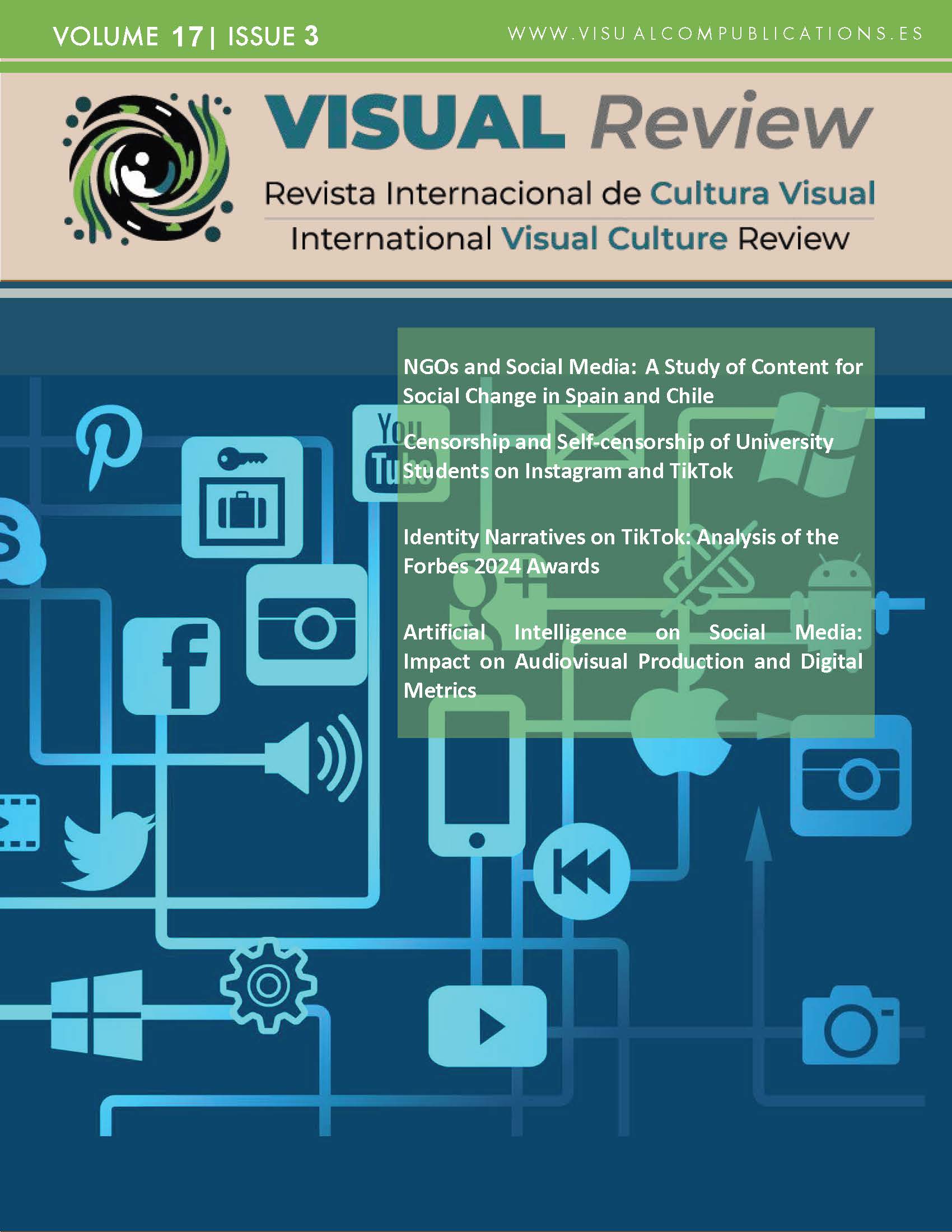Communication, Social Media and Adolescence
The Use of Social Media in Adolescent Communication in the Basque Country and Navarre
DOI:
https://doi.org/10.62161/revvisual.v17.5791Keywords:
Social Media, Communication, Digital interactivity, Offline communication, AdolescentsAbstract
This article examines how adolescents in the Basque Country and Navarre use social media in their daily communication. The findings highlight the integration of these tools into the social lives of youth and a general preference for face-to-face interactions for more personal topics. However, the study also reveals how digital platforms influence in-person dynamics, emphasizing the importance of balancing both communication modes and fostering a critical and responsible approach to social media.
Downloads
Global Statistics ℹ️
|
759
Views
|
1062
Downloads
|
|
1821
Total
|
|
References
AIMC (2024). Navegantes en la Red. Edición 26º. Asociación para la Investigación de Medios de Comunicación. https://www.aimc.es/a1mcc0nt3nt/uploads/2024/03/Navegantes2023.pdf
Anderson, M., Faverio, M. y Gottfried, J. (2023). Teens, Social Media & Technology 2013. Pew Research Center. Recuperado de https://bit.ly/4ggBxQZ
Anderson, M., Faverio, M. y Gottfried, J. (2023). Teens, Social Media and Technology 2023 YouTube, TikTok, Snapchat and Instagram remain the most widely used online platforms among U.S. teens. Pew Research Center. https://bit.ly/4jm68Q9
Aucapiña, E., y Campodónico, N. M. (2024). Revisión sistemática sobre la influencia de las redes sociales en la autoestima de los adolescentes. Revista de Psicología UNEMI, 8(15), 73-87. https://doi.org/10.29076/issn.2602-8379vol8iss15.2024pp73-87p
Burnette, C. B., Kwitowski, M. A. y Mazzeo, S. E. (2017). I don’t need people to tell me I’m pretty on social media: A qualitative study of social media and body image in early adolescent girls. Body Image, 23, 114-125. https://doi.org/10.1016/j.bodyim.2017.09.001
Gallego-Pérez, I. (2009). Podcasting: distribución de contenidos y nuevas formas de negocio en la empresa radiofónica española. [Tesis Doctoral] Universidad Complutense de Madrid, España.
DataReportal (2024). Digital 2024: Global overview report. DataReportal, We are social y Hootsuite. https://datareportal.com/reports/digital-2024-global-overview-report
Fioravanti, G., Casale, S., Benucci, S., B., Prostamo, A., Falone, A., Ricca, V. y Rotella, F. (2021). Fear of missing out and social networking sites use and abuse: A meta-analysis. Computers in Human Behavior, 122. https://doi.org/10.1016/j.chb.2021.106839
Hooft Graafland, J. (2018). New technologies and 21st century children: Recent trends and outcomes. OECD Education Working Papers, 179. https://doi.org/10.1787/e071a505-en.
IAB (2024). Estudio de redes sociales 2024. España: Interactive Advertising Bureau Spain y ELOGIA. https://iabspain.es/estudio/estudio-de-redes-sociales-2024/
Kaspersky (2023) Estar en línea: Niños y padres en Internet. https://bit.ly/4g81Clj
Kross, E., Verduyn, P., Demiralp, E., Park, J., Lee, D. S., Lin, N., Shablack, H., Jonides, J. e Ybarra, O. (2013). Facebook Use Predicts Declines in Subjective Well-Being in Young Adults. PLOS ONE, 8(8). https://doi.org/10.1371/journal.pone.0069841
Lenhart, A. (2015). Teens, Technology and Friendships. Pew Research Center. https://www.pewresearch.org/internet/2015/08/06/teens-technology-and-friendships/
Martínez, M. G. y Olsson, T. (2019). The youth and social media: From selfie generation to social good en J. Burgess, A. Marwick y T. Poell, (Eds), The SAGE Handbook of Social Media (pp. 206-219). SAGE Publications Ltd.
Moreno, M. A. y Gannon, K. (2013). Social media and health. Adolescent medicine: state of the art reviews, 24(3), 538-552. https://doi.org/10.1542/9781581108736-social_media
Muppalla, S. K., Vuppalapati, S., Pulliahgaru, A. R., Sreenivasulu, H. y kumar Muppalla, S. (2023). Effects of Excessive Screen Time on Child Development: An Updated Review and Strategies for Management. Cureus, 15(6). https://doi.org/10.7759/cureus.40608
Nesi, J., Choukas-Bradley, S. y Prinstein, M. J. (2018). Transformation of Adolescent Peer Relations in the Social Media Context: Part 1-A Theoretical Framework and Application to Dyadic Peer Relationships. Clinical child and family psychology review, 21(3), 267-294. https://doi.org/10.1007/s10567-018-0261-x
Pérez-García, Á., Suárez-Perdomo, A., López-Martínez, A. y Martínez-Fernández, G. (2024). Los adolescentes y la construcción del pensamiento crítico para la gestión de los retos y las noticias falsas en las redes sociales. Aloma: Revista De Psicologia, Ciències De l’Educació I De l’Esport, 42(1), 59-67. https://doi.org/10.51698/aloma.2024.42.1.59-67
Primack, B. A., Shensa, A., Escobar-Viera, C. G., Barrett, E. L., Sidani, J. E., Colditz, J. B., & James, A. E. (2017). Use of multiple social media platforms and symptoms of depression and anxiety: A nationally-representative study among U.S. Young adults. Computers in Human Behavior, 69, 1-9. https://doi.org/10.1016/j.chb.2016.11.013
Reich, S. M., Subrahmanyam, K., & Espinoza, G. (2012). Friending, IMing, and hanging out face-to-face: Overlap in adolescents' online and offline social networks. Developmental Psychology, 48(2), 356-368. https://doi.org/10.1037/a0026980
Reid-Chassiakos, Y. L., Radesky, J., Christakis, D., Moreno, M. A., Cross, C. y Council on communications and media (2016). Children and Adolescents and Digital Media. Pediatrics, 138(5), e20162593. https://doi.org/10.1542/peds.2016-2593
Ricci, R. C., Paulo, A. S. C., Freitas, A. K. P. B., Ribeiro, I. C., Pires, L. S. A., Facina, M. E. L., Cabral, M. B., Parduci, N. V., Spegiorin, R. C., Bogado, S. S. G., Chociay Junior, S., Carachesti, T. N., & Larroque, M. M. (2022). Impacts of technology on children’s health: a systematic review. Revista Paulista de Pediatria, 41. https://doi.org/10.1590/1984-0462/2023/41/2020504
Rideout, V. y Robb, M. B. (2018). Social Media, Social Life: Teens Reveal Their Experiences. Common Sense Media. https://bit.ly/4h6mMlc
Rubio-Hernández, F. J., González-Calahorra, E. y Olivo-Franco, J. L. (2024). Adolescentes en la era digital. Desvelando las relaciones entre las redes sociales, el autocontrol, la autoestima y las habilidades sociales. Ciencia y Educación, 8(3), 39-58. https://doi.org/10.22206/cyed.2024.v8i3.3209
Sánchez-Vera, M., Serrano, J. y Prendes, P. (2013). Análisis comparativo de las interacciones presenciales y virtuales de los estudiantes de enseñanza secundaria obligatoria. Educación XX1, 16(1), 351-374. https://doi.org/10.5944/educxx1.16.1.730
Schmuck, D., Karsay, K., Matthes, J. y Stevic, A. (2019). Looking up and feeling down’. The influence of mobile social networking site use on upward social comparison, self-esteem, and well-being of adult smartphone users. Telematics and Informatics, 42. https://doi.org/10.1016/j.tele.2019.101240
Tandon, A., Dhir, A., Talwar, S., Kaur, P. y Mäntymäki, M. (2021). Dark consequences of social media-induced fear of missing out (FoMO): Social media stalking, comparisons, and fatigue. Technological Forecasting and Social Change, 171, 1-15. https://doi.org/10.1016/j.techfore.2021.120931
Throuvala, M. A., Griffiths, M. D., Rennoldson, M. y Kuss, D. J. (2019). Motivational processes and dysfunctional mechanisms of social media use among adolescents: A qualitative focus group study. Computers in Human Behavior, 93, 164-175. https://doi.org/10.1016/j.chb.2018.12.012
Turkle S. (1997). Life on the Screen: Identity in the age of the internet. Simon & Schuster.
Turkle, S. (2015). Reclaiming Conversation: The Power of Talk in a Digital Age. Penguin Press.
Uhls, Y. T., Ellison, N. B. y Subrahmanyam, K. (2017). Benefits and Costs of Social Media in Adolescence. Pediatrics, 140(S2), S67–S70. https://doi.org/10.1542/peds.2016-1758E
UNICEF (2021) Impacto de la tecnología en la adolescencia. https://bit.ly/4h79swL
Valkenburg, P. M. y Peter, J. (2011). Online communication among adolescents: An integrated model of its attraction, opportunities, and risks. Journal of Adolescent Health, 48(2), 121-127. https://doi.org/10.1016/j.jadohealth.2010.08.020
Vannucci, A. y Mccauley-Ohannessian, C. (2019). Social media use subgroups differentially predict psychosocial well-being during early adolescence. Journal of Youth and Adolescence, 48, 1469-1493. https://doi.org/10.1007/s10964-019-01060-9
Downloads
Published
How to Cite
Issue
Section
License
Copyright (c) 2025 Authors retain copyright and transfer to the journal the right of first publication and publishing rights

This work is licensed under a Creative Commons Attribution-NoDerivatives 4.0 International License.
Those authors who publish in this journal accept the following terms:
-
Authors retain copyright.
-
Authors transfer to the journal the right of first publication. The journal also owns the publishing rights.
-
All published contents are governed by an Attribution-NoDerivatives 4.0 International License.
Access the informative version and legal text of the license. By virtue of this, third parties are allowed to use what is published as long as they mention the authorship of the work and the first publication in this journal. If you transform the material, you may not distribute the modified work. -
Authors may make other independent and additional contractual arrangements for non-exclusive distribution of the version of the article published in this journal (e.g., inclusion in an institutional repository or publication in a book) as long as they clearly indicate that the work was first published in this journal.
- Authors are allowed and recommended to publish their work on the Internet (for example on institutional and personal websites), following the publication of, and referencing the journal, as this could lead to constructive exchanges and a more extensive and quick circulation of published works (see The Effect of Open Access).













